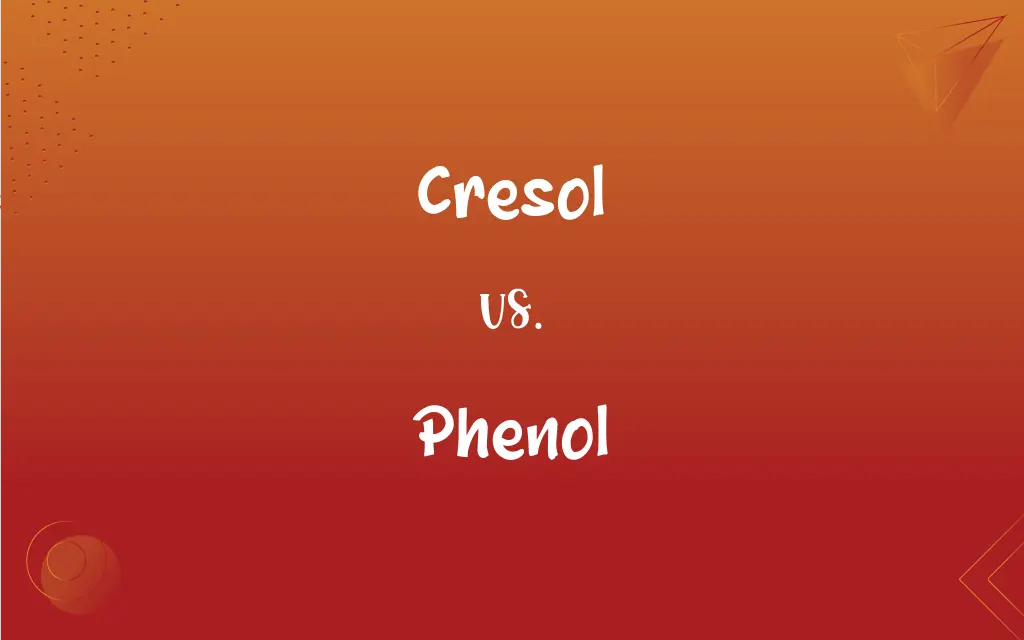Cresol vs. Phenol: What's the Difference?
Edited by Aimie Carlson || By Janet White || Published on January 29, 2024
Cresol is a mixture of three isomeric compounds derived from phenol with a methyl group attached, while phenol itself is a simpler compound, often used as a precursor in the manufacture of other materials.

Key Differences
Cresol is composed of three isomers: ortho-, meta-, and para-cresol, each with a methyl group attached to the aromatic ring, differentiating it from phenol, which is a single compound without any methyl group.
In terms of chemical structure, cresols have a higher molecular weight compared to phenol due to the additional methyl group, while phenol consists of a hydroxyl group directly bonded to a benzene ring.
Cresol is used in disinfectants, resins, and as a precursor in the synthesis of other chemicals, whereas phenol is widely used in the production of plastics, explosives, and pharmaceuticals.
From a safety perspective, both cresol and phenol are toxic and corrosive, but cresol's toxicity varies slightly depending on its isomeric form, whereas phenol's toxicity is more consistent.
In industrial applications, cresol's varying isomers allow for more specialized uses compared to phenol, which is often employed in broader applications due to its simpler structure.
ADVERTISEMENT
Comparison Chart
Chemical Structure
Mixture of three isomers with a methyl group
Simple aromatic ring with a hydroxyl group
Molecular Weight
Higher due to the methyl group
Lower without the additional group
Uses
Disinfectants, resins, chemical synthesis
Plastics, explosives, pharmaceuticals
Toxicity
Varies with isomer, generally toxic
Consistently toxic and corrosive
Industrial Applications
Specialized uses due to isomer variation
Broader uses due to simpler structure
ADVERTISEMENT
Cresol and Phenol Definitions
Cresol
A compound consisting of a methyl group attached to a phenol molecule.
Cresol is used in certain disinfectants.
Phenol
An aromatic organic compound with a hydroxyl group bonded to a benzene ring.
Phenol is a basic compound in organic chemistry.
Cresol
A component in the manufacture of synthetic resins.
Cresol is a key ingredient in some resin formulations.
Phenol
A substance derived from coal tar and used industrially.
Industrial phenol is often derived from coal tar.
Cresol
Any of three isomeric compounds derived from phenol.
Ortho-cresol is one of the isomers of cresol.
Phenol
A compound used in the manufacture of explosives.
Phenol derivatives are components of some explosives.
Cresol
A precursor in the synthesis of other chemicals.
Cresol is used in producing various industrial chemicals.
Phenol
A precursor in the production of plastics and pharmaceuticals.
Phenol is used in the synthesis of aspirin.
Cresol
A substance found in coal tar and used for disinfection.
Coal tar cresol has applications in disinfection processes.
Phenol
A toxic, colorless crystalline solid with antiseptic properties.
Phenol is used for its antiseptic qualities in some products.
Cresol
Any of three isomeric phenols, C7H8O, used in resins and as a disinfectant.
Phenol
A caustic, poisonous, white crystalline compound, C6H6O, derived from benzene and used in resins, plastics, and pharmaceuticals and in dilute form as a disinfectant. Also called carbolic acid.
Cresol
(chemistry) Any of the three isomeric phenols derived from toluene: ortho-, meta- or para-methylphenol.
Phenol
Any of a class of aromatic organic compounds having at least one hydroxyl group attached directly to the benzene ring.
Cresol
Any one of three metameric substances, CH3.C6H4.OH, homologous with and resembling phenol. They are obtained from coal tar and wood tar, and are colorless, oily liquids or solids. [Called also cresylic acid.]
Phenol
A caustic, poisonous, white crystalline compound, C6H5OH, derived from benzene and used in resins, plastics, and pharmaceuticals and in dilute form as a disinfectant and antiseptic; once called carbolic acid
Cresol
Any of three poisonous colorless isomeric phenols; derived from coal or wood tar; used as a disinfectant
Phenol
Any of a class of aromatic organic compounds having at least one hydroxyl group attached directly to the benzene ring (or other aromatic ring)
Phenol
A white or pinkish crystalline substance, C6H5OH, produced by the destructive distillation of many organic bodies, as wood, coal, etc., and obtained from the heavy oil from coal tar.
Phenol
Any one of the series of hydroxyl derivatives of which phenol proper is the type.
Phenol
Any of a class of weakly acidic organic compounds; molecule contains one or more hydroxyl groups
Phenol
A toxic white soluble crystalline acidic derivative of benzene; used in manufacturing and as a disinfectant and antiseptic; poisonous if taken internally
FAQs
Is cresol toxic?
Yes, it's toxic and can vary slightly depending on the isomer.
What is cresol?
Cresol is a mixture of three isomeric compounds derived from phenol.
What are common uses of phenol?
In the production of plastics, explosives, and pharmaceuticals.
How is phenol different from cresol?
Phenol is a simpler compound without a methyl group, unlike cresol.
What are the isomers of cresol?
Ortho-, meta-, and para-cresol.
Can cresol be used in disinfectants?
Yes, it's a component in some disinfectant formulations.
Are cresols found naturally?
They can be found in coal tar and some natural sources.
Can cresol be used in resin manufacturing?
Yes, especially in synthetic resins.
What is the role of phenol in plastic production?
It's a key precursor in making certain types of plastics.
Is phenol an antiseptic?
Yes, it has antiseptic properties.
Can cresol be used in chemical synthesis?
Yes, as a precursor for various chemicals.
What is the molecular structure of phenol?
A hydroxyl group bonded to a benzene ring.
How is cresol produced industrially?
Often from coal tar or by methylation of phenol.
How is phenol extracted?
Typically from coal tar or through synthetic processes.
Is phenol environmentally hazardous?
It can be, particularly if not handled or disposed of properly.
Is phenol used in medicine?
Yes, as a precursor in pharmaceutical synthesis.
What precautions are needed when handling phenol?
Proper protective equipment and ventilation due to its toxicity.
Are there safety concerns with cresol?
Yes, due to its toxicity and corrosive nature.
What makes phenol important in organic chemistry?
Its basic structure and reactivity make it a fundamental compound.
Do cresols have varied industrial applications?
Yes, due to the different properties of its isomers.
About Author
Written by
Janet WhiteJanet White has been an esteemed writer and blogger for Difference Wiki. Holding a Master's degree in Science and Medical Journalism from the prestigious Boston University, she has consistently demonstrated her expertise and passion for her field. When she's not immersed in her work, Janet relishes her time exercising, delving into a good book, and cherishing moments with friends and family.
Edited by
Aimie CarlsonAimie Carlson, holding a master's degree in English literature, is a fervent English language enthusiast. She lends her writing talents to Difference Wiki, a prominent website that specializes in comparisons, offering readers insightful analyses that both captivate and inform.







































































